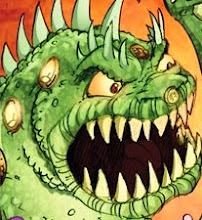Because I'm at a loss for a topic, I'm going to follow Alwen's idea, and give a list of things I've been researching and reading about lately. Brace yourselves. It's a freaky list. (Big shock.)
The most interesting thing (maybe) is the
Lizard Man of Lee County. Evidently, South Carolina has its own variation on the Big Foot legend; this time it's a seven foot tall lizard thingie that lives in the swamp. I was hoping for a long tradition, but the legend only goes back to 1988, which is kinda disappointing. The
Jersey Devil goes back to the 1700s, after all. Anyway, a seven foot lizard with glowing red eyes makes me wonder exactly what kinds of mushrooms are growing in those swamps. At least I know what to throw at the husbeast tonight, when he gets home, to freak him out. We're in a swamp. By golly, I think I see a seven foot lizard out there RIGHT NOW! AAAAAAH!
Another thing I've been looking into is how glow-in-the-dark pigments 'work'. I can't get into gory details though... for some reason they seem reluctant to get into atomic structure in articles. But it all puts me in mind of an old Bloom County cartoon, where Oliver (the boy genius) builds a nuclear warhead for Science Fair. When the teacher asks where he got the fissionable material, he says he scraped the glow-in-the-dark paint off several thousand old watch faces. (In fact, that's a running joke around here, building a nuke with silly ingredients like that, since the husbeast is trained to work on nuclear power plants.)
And then there's leeks. Yeah, like the food. The blame for this one I lay squarely at the feet of Alton Brown; his Good Eats
episode on leeks was on last night. (Incidentally, there's a great selection of quickie how-to videos by him, available
here.) He was doing freaky leek facts through history, and being me, I started wondering where/when they'd been domesticated. So a quick pop over to
Food Timeline ensued. (I should know better, because I can't hit that site and spend LESS than half an hour reading things I never knew about all kinds of foods I've never eaten, while going "oh, cool".) Onions (to which leeks are related) were eaten back to the stone age, but it's thought they were domesticated somewhere in the middle east/central Asia around 3500 BCE. They became popular in Europe particularly, and according to what I've read, vegetables in Europe during the middle ages were pretty much cabbage, onions, and beans. That's it. Yum. (Which puts me in mind of that joke, "British cuisine has three vegetables, and two of them are cabbage.") I also find, in my cruising of the 'net, that some
research group is trying to genetically 'fingerprint' garlic, so they can trace it's evolution and migration. My first thought on that is WHY, but hell, it beats research on nuclear warheads, right? Maybe? Can we develop some new antibiotics yet?
Ahem. Where was I? Right. Leeks. They seem to be native to the Mediterranean area, and have been domesticated for about three thousand years. They're popular in Europe, but haven't spread in fame like regular onions have. The reason for my curiosity is, I'm allergic to sulfur, which means I am allergic to the 'hot' taste causing chemicals in the onion family - they're all based on sulfur compounds. (And the reason cutting onions bothers your eyes is, those compounds turn to sulfuric acid when they hit the moisture in your eyes.) So years ago, unable to consume big portions of onions and garlic, I began fooling around with using leeks instead. And I found that not only was I able to eat them, but they were yummy! These days I use leeks in place of onions in almost everything. And when a recipe requires mirepoix (carrots, onions, and celery), I just use carrots and leeks - the taste of the leek is sort of like celery and onion together, and I can get away with it.
Damn. Now I wanna make
cock-a-leekie soup.
Anyway. I'm now going to go knit while brooding over a Knitty article I can't write until an order of silk and wool gets here. (It is due tomorrow.) Since I am almost pain free for the first time in weeks, I may babble again later. On the history of handkerchiefs, or cartoons, or, I don't know, Chinese ceramics. Or maybe I'll build a draw loom on the back porch. You never know around here.












































